Sonoff TRVZB is the new device from Sonoff. It is a smart thermostatic head that uses Zigbee technology and allows you to adjust the temperature of an area of your home from your phone.
Why is the Sonoff TRVZB Thermostatic Valve priced like this?
As it is a smart thermostatic head, it has a higher price compared to a traditional thermostatic head. But if we compare this Sonoff TRVZB model with other smart thermostatic valves, Sonoff is very competitively priced.
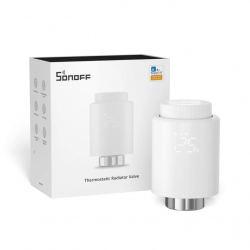
Advantages and Disadvantages of the Sonoff Thermostatic Valve TRV ZB
Advantages
- Zigbee technology: Zigbee is a very good option for unifying a smart home with low power consumption, encrypted communications and mesh networking.
- Compatibilities: You can use this Zigbee smart head with a Sonoff hub, Home Assistant, Jeedom or even Amazon Alexa voice assistants that integrate a Zigbee hub.
- Features: Open window detection, child safety, frost protection are some of the features integrated with this Sonoff head.
- Adapters: The adapters included with the head allow the device to be easily installed on most radiators at no extra cost.
- Quality/price: Sonoff is a specialist in offering good quality devices at a reduced price.
Disadvantages
- You need a Zigbee hub: In addition to the purchase of one or more Sonoff thermostatic heads, you need to buy a compatible hub.
Sonoff TRVZB compatibility with radiators
Download the PDF on the compatibility of the thermostatic head with different radiators.
Sonoff TRVZB Thermostatic Head Tutorial
If you are not yet familiar with Sonoff, you should know that it is a major player in the smart home market, with a variety of devices that communicate via WIFI technology and also Zigbee technology.

Sonoff’s great success, in my opinion, is due to the incredibly low price of several of its devices.

For approximately 10 to 15 euros, they can purchase a smart module to manage lights or electrical devices, a temperature and humidity sensor to control heating, a motion sensor to create comfort or security routines, a door and window sensor to, for example, turn off the heating when a window is opened or receive an alert when they are away from home and someone opens a window…

These are examples of devices that are having great success and, in addition to their price, they usually stand out for their very small size, being among the smallest devices on the market.

One of the great advantages of a smart home is to be able to achieve energy savings, and for this there are different options, one of them is to replace traditional thermostatic heads with smart thermostatic heads to be able to control the temperature from your phone anywhere in the world and create automations so that the temperature is adjusted according to your presence or absence.

We have already seen in other content how we have implemented smart thermostatic showerheads in a user’s home.

And we have created time schedules so that during working hours and at night, when the user and the family are in bed, the heating is set to economy mode and during mornings and evenings, when the user and the family are actively present in the house, the heating is set to comfort mode.

The first advantage of this Sonoff thermostatic head is that it uses the famous Zigbee technology.

This Zigbee technology, which is used by many brands, allows you to unify your entire installation in a single interface thanks to a universal home automation hub, such as Jeedom and Home Assistant.

This means that with Home Assistant or Jeedom with Zigbee2MQTT, you can add multiple Zigbee smart devices, such as the Sonoff thermostat head.

It is very practical to be able to have the freedom to mix brands, because we do not depend on just one brand, so we do not run risks if the company goes bankrupt or abandons its project, and also if we want to personalise our installation as much as possible.

For example, the user has chosen MOES thermostatic heads, but is now going to implement a Sonoff thermostatic head, and they can all be on the same interface with Jeedom or Home Assistant.

Let’s open the packaging of the device. We find a guide.

The thermostatic head has a default format of M30x1.5, but there are additional adapters in RA, M28, CAL, RAV, GIA, RAVL formats.

They also have a sheet with a QR code of an installation video.

As you have seen, this Sonoff thermostatic head is white.

On the front, there is a button that will allow the device to be included if pressed.

And also control the temperature, from 4°C to 35°C, manually by turning this knob.
And they have a display that will show the set temperature and other functions of the device, such as its current mode, battery status or also when it is in inclusion mode.

A very practical detail is that they have a button to remove the battery holder without having to uninstall the thermostatic head.

They simply push the holder out, and another practical detail is that this device uses 3 batteries in double AA LR6 format, which are not included but are easy to find in any shop.

And next to the display, you have a button and if you press it for 3 seconds, it will change the direction of the information displayed on the screen.

This can be very practical depending on the position in which the thermostatic head is installed.

Importantly, this Sonoff TRVZB thermostatic head has a protection option so that children cannot change the temperature, and it also has an open window detection function to automatically reduce the temperature from the thermostatic head to avoid energy costs.

And last but not least, it has a frost protection function to prevent damage to the pipes.

To install the Sonoff TRVZB thermostatic head, you must first remove your traditional thermostatic head.

Now, place the batteries in your Sonoff TRVZB thermostatic head and wait until the symbol on the display stops flashing.

Now, you can install the thermostatic head and press the middle button once. The “AD” symbol should flash for a few seconds.

Now, there will be a countdown and you will be able to start the inclusion mode of your home automation controller (in Zigbee2MQTT, you have to press the button on the top right).

Turn the knob on the thermostatic head to the OFF position.

And press the button for 3 seconds. You will see a wave icon which means you are in inclusion mode.

The TRVZB thermostatic head should now appear on the Zigbee2MQTT interface.

We have access to different settings such as the temperature control we want to set in our house, the currently measured temperature, the local temperature calibration, the current mode, the current running status, the battery status, the child protection.

We also have the possibility to automatically switch off the head if it detects the open window, we can set a frost protection temperature and we can set other technical details of the device.

We can set a percentage of opening and closing of the valve in the open and closed state.
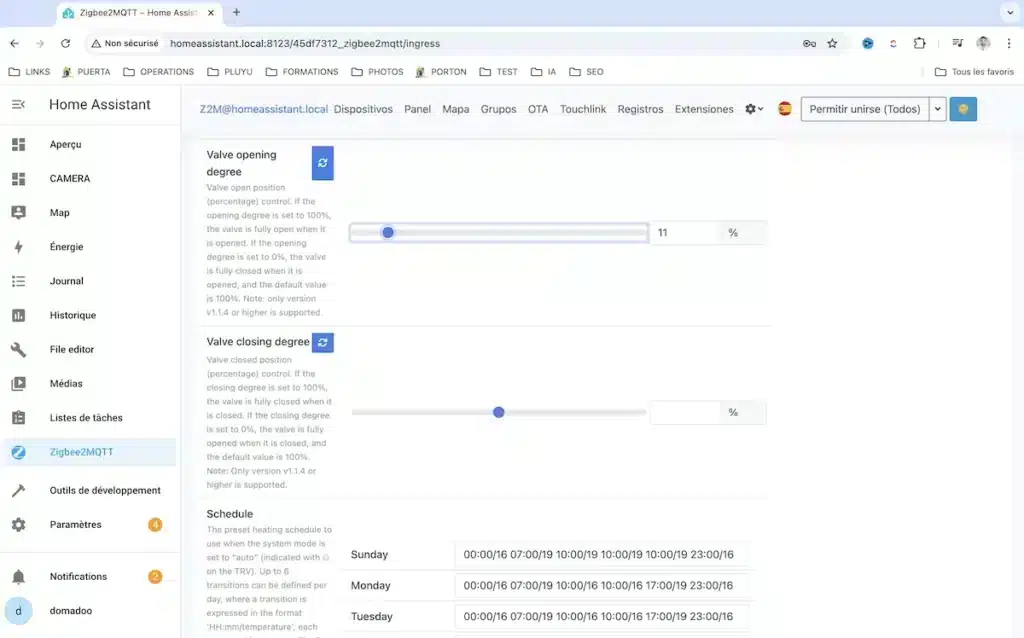
Another interesting detail is being able to define time schedules with temperatures defined directly in the TRVZB head (if we use its AUTO mode).

And finally, you should know that you can change the unit of measurement from Celsius to Fahrenheit.

In our case, given that the user already had thermostatic heads and programming during the week, we will simply add this Sonoff TRVZB thermostatic head to his configuration so that it will be one more device acting in his house and thus further optimise the heating and, therefore, the energy costs.

And thanks to the home automation hub, as well as being able to create different programmes, we can also monitor the temperature measured by the thermostatic head over time.

Of course, you can also use this Sonoff TRVZB thermostatic head with another home automation hub, such as one of Sonoff’s own brand.

And if you link your home automation hub with a voice assistant, such as Amazon Alexa, you will have voice control of the temperature of your thermostatic head.

Once again, Sonoff launches a device that is a great success in the smart home market due to its interesting functions, outstanding design and very competitive price.

Images of Sonoff TRVZB
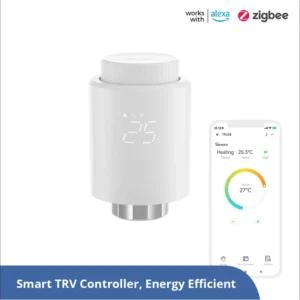





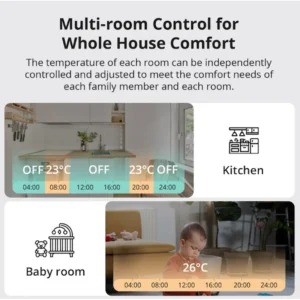



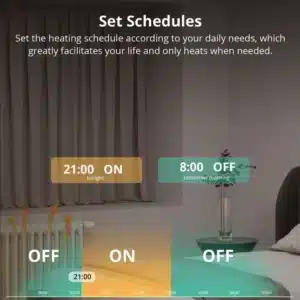

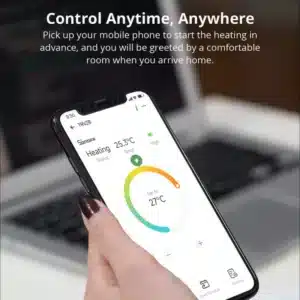


Zigbee TRVZB Thermostatic Zigbee Head User Manual
Technical Characteristics of the Zigbee Thermostatic Valve TRV
- Model: TRVZB
- Wireless connection: Zigbee 3.0
- Compatibilities with Zigbee hubs:
- Sonoff
- Jeedom
- Home Assistant
- Eedomus
- Zigbee2MQTT
- Alexa
- Colour: White
- Input: 4.5 V ⎓ (3 x 1.5 V AA batteries)
- Net weight: 154 g
- Battery model: AA LR6 1.5 V alkaline batteries
- Case material: PC
- Threaded connection: M30x1.5 mm
- Temperature setting range: 4 °C to 35 °C
- Product dimensions: 59,4 × 59,4 × 95 mm
Bought together
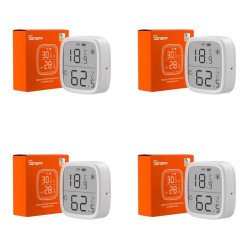

Buy now your Sonoff Thermostatic Smart Valve TRVZB

Graduated with a Higher Technician’s Certificate in Home Automation, a Professional Bachelor’s degree in E-commerce and Digital Marketing, and a Master’s degree in SEO, I have been working since 2013 in a home automation e-commerce company called Domadoo, where I have the opportunity to test a large number of the popular Smart Home products on the market.














